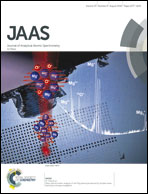Elemental imaging by laser-induced breakdown spectroscopy for the geological characterization of minerals†
Abstract
Geological studies increasingly require highly sensitive elemental techniques able to image the distribution of elements in minerals with microscopic-scale resolution. In this paper, we present an evaluation of megapixel laser-induced breakdown spectroscopy (LIBS) imaging for the geological characterization of minerals. The study is conducted on a hydrothermal ore sample with a complex mineral structure involving five different mineral phases (galena, sphalerite, chalcopyrite, quartz and ankerite). A new methodology of data treatment adapted to a multi-phase material and megapixel LIBS imaging is also detailed. We demonstrate for the first time, to our knowledge, that LIBS-imaging technology is able to both detect and image rare earth elements (here La and Y) in carbonate as well as substituents present at the ppm-scale level in various mineral phases (i.e., cadmium in sphalerite; bismuth, silver and antimony in galena; beryllium and aluminum in quartz; and tin in chalcopyrite). These results appear extremely promising for the geological domain and should pave the way for innumerable applications.

- This article is part of the themed collection: JAAS Recent HOT articles


 Please wait while we load your content...
Please wait while we load your content...